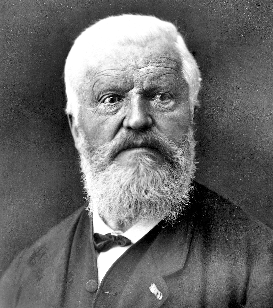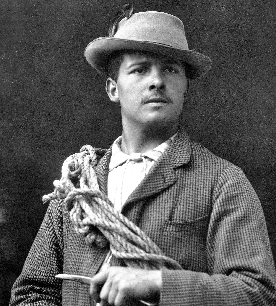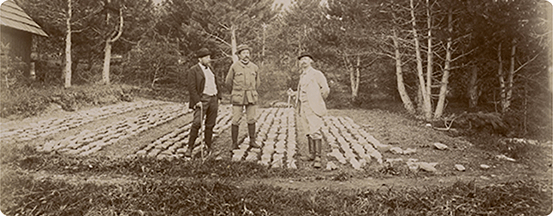The Tairraz family, a dynasty of mountaineer photographers
Three men from the Tairraz family, mountain guides from Chamonix, photographed the Mont Blanc glaciers every year from 1891 through to 1933. Their photographs provide invaluable data for tracking the evolution of the glaciers from the industrial revolution to the 20th century. Today, they are greatly threatened by global warming.

Joseph (1827-1902), the pioneer, starts high mountain photography in 1857

In the Tairraz family, in Chamonix, there is first Joseph, the grandfather who pioneers high mountain photography. In 1857, he learns the daguerreotype and buys a 21 x 27 cm camera with which he takes his first mountain photographs. That same year, he creates the "Photographie Alpine Tairraz" studio and guides the glaciologist John Tyndall on the Mer de Glace glacier, taking part in a scientific expedition on the movement of the glacier. A few years later, he invents a measuring method by installing fixed markers on the banks of the glacier.
Georges I (1868-1924) expands the family photography studio at the end of the 19th century

Georges I, one of Joseph's sons, is also a guide and photographer and takes over the family studio in the 1890s after an apprenticeship with Monsieur Pierre Petit in Paris. While continuing his work as a photographer and publisher, he accompanies mountaineers on their expeditions. At the end of the 19th century taking pictures at altitude requires considerable logistics due to the weight of the camera and the glass plates (he uses a 50 x 60 cm format), as well as excellent technical skills given the climatic conditions.
George II (1900-1975), a pioneer in high mountain photography, is a friend of Frison-Roche and Rébuffat

Georges II (1900-1975), one of Georges I's sons, succeeds him and develops the family business by turning to film as early as 1930. He becomes an essential cameraman for high mountain shots and befriends Roger Frison-Roche and Gaston Rébuffat while filming in the Alps.
Photographs taken year after year at the same locations
For nearly half a century, Joseph, Georges I and Georges II took turns climbing to the fronts of the glaciers. Positioned in the same places with the help of the markers they had set up, they took the same photographs, thus contributing to the monitoring of these giants of ice, now under threat.
With Pierre (1933-2000), change in continuity

Although the photographic campaigns of follow-up measurements stop with him, Pierre does not escape the family passion: he studiedsphotography and cinema in Paris before returning to train in the field with his father Georges II. He then joins expeditions to several mountain ranges as a film-maker. He works with Roger Frison-Roche (illustrating the books Mont Blanc and the Seven Valleys and 50 ans en montagne) and also works with Gaston Rébuffat.
Major scientific data
These 200 old photographs constitute major scientific data by providing a time reference and allowing the evolution of the glaciers to be followed over the years. The monitoring of these giants remains a topical issue: they are suffering the full force of the consequences of global warming and are at risk of disappearing completely.
Some examples of glacier research at INRAE
Why are glaciers melting?
Researchers from Grenoble shed new light on the causes of the recent record glacier melts and their impact in the context of global warming, thanks to INRAE’s monitoring of the Sarennes glacier for almost 70 years. Immerse yourself in the Sarennes glacier with this podcast (in french) and learn more about the work of scientists in the field.
See also
- Artificial intelligence helps scientists to better predict the evolution of glaciers under climate change (in french) (23/01/2022)
- Ecological impacts of glacier melt (in French) (22/04/2020)
- Melting glaciers cause sea levels to rise (in French) (08/04/2019)
- Observatory of the Glacier Blanc (in French)
Text written by Catherine Tailleux (INRAE-DipSO).
Many thanks to Valérie Pesenti and Caroline Soissons, the daughters of Pierre Tairraz, for their contribution
How to cite: Agate Focus:The Tairraz family, a dynasty of mountaineer photographers, Catherine Tailleux (INRAE-DipSO), march 2023, https://agate.inrae.fr/agate/en/content/highlights



